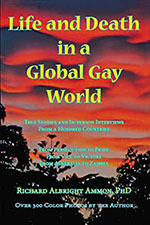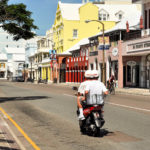Wuhan City and Mao
Tiberius had Capri, Frederick the Great had Sans Soucci, and the Ming Emperors had the Forbidden City. Where there is power there are also regal retreats and hide-aways– and usually built for secrecy and safety.
 A recent self-arranged trip down the Yangtze River (first class on a third-class Chinese boat) landed us at one of these famous retreats, this one in the city of Wuhan about five hundred miles west of Shanghai.
A recent self-arranged trip down the Yangtze River (first class on a third-class Chinese boat) landed us at one of these famous retreats, this one in the city of Wuhan about five hundred miles west of Shanghai.
Most people arrive in Wuhan to start or finish their Yangzte cruise spending only a few hours passing through, but we decided to pause for a day when we read about one of the most famous yet least frequented attractions in China: Mei Ling, Chairman Mao Zedong’s secluded residential compound in the wooded outskirts of this provincial capital of four million.
Getting to the isolated place from our hotel was a notable chore. Chinese taxi drivers don’t speak English and we don’t speak Mandarin. Fortunately, hotel staff were among the most fluent English speakers we met during our two weeks of unguided travel and they gave perfect instructions to our taxi driver–well, almost perfect.
 Our taxi made a prolonged ride past countless tiny merchant shops (selling mostly low tech household goods), smoky curbside kitchens, swarms of parked bicycles, glossy restaurants guarded by sleepy stray dogs, dismal apartment buildings festooned with laundry–all of which thinned out as we wove further toward the outskirts of the city.
Our taxi made a prolonged ride past countless tiny merchant shops (selling mostly low tech household goods), smoky curbside kitchens, swarms of parked bicycles, glossy restaurants guarded by sleepy stray dogs, dismal apartment buildings festooned with laundry–all of which thinned out as we wove further toward the outskirts of the city.
At some point, our taxi driver ventured beyond his usual turf as he hunted for street signs, few as they were, searching for further directions. Finally he stopped to ask for help; we saw fingers jabbing the air toward the direction we had come from. Another mile or so back, retracing his route slowly, studying signs and asking a second time, the driver–muttering aloud to himself by now–finally pulled into the unposted and anonymous entrance to the obscure place known as Mei Ling.
Most Chinese people, we had read, are still not aware of the existence of this place; we now knew why. During our two-hour visit to the hidden estate, we saw perhaps half a dozen other visitors walking around.
If the language was strange, so was some of the behavior: our taxi driver got out as we did and walked to the ticket booth and started talking to the clerk. The conversation was obviously more than just an inquiry as the tone of their exchange became tense and then heated after several minutes.
Waiting to buy our tickets, we hadn’t a clue what was wrong or why the driver was becoming so agitated. Finally, I moved forward and asked to buy our tickets and to offer to pay for our ride. The ticket clerk spoke very little English and said something like “you…taxi…no me pay…” With these few words and even more hand signals we managed to sort things out: apparently the driver expected the ticket seller to pay him for the ride and collect it from us.
The logic defied us, but he did get paid and we bought our tickets ($2.50 each) and proceeded past the two stiff-backed adolescent army guards watching this whole exchange with probably some interest since they had nothing else to do.
Entering Mei Ling, Finally

After our little dance with language and money, we strolled down a long tree-lined drive into the silence of this once-forbidden enclave. Mei Ling was built in 1958 as a retreat for Mao and other privileged ruling members of the politburo. Mao nicknamed the place “home of the white clouds and yellow cranes” and enjoyed the quiet ambiance and great relief it offered. He stayed here more than twenty times during his unpredictable rule, once for more than a year during the violence of the Cultural Revolution of the late sixties.
There are three main buildings: the Chairman’s private villa, a hotel-sized guesthouse and an assembly hall for large meetings. Set on a quiet sylvan shore along one of Wuhan’s several lakes, the park like surroundings are studded with trees, walking paths, tennis court, gardens, a boat house, an ornate oriental gazebo–what you might expect to see at such a private estate. Apparently, however, Mao’s wife, Jiang Qing, did not feel so enraptured with the place. She stayed here only three times over the years.
 Surely the most unusual building is a short hundred yards from Mao’s front door. Among the tall trees and surrounded by dried up flowerbeds is a large stone and glass building housing Mao’s private indoor swimming pool.This is no splash pool either. It’s about 30 meters long and five lanes wide–about the size of most competition pools. As a swimmer, I know a decent pool when I see one and this structure was top notch when it was built. Apparently the Communist boss favored aristocratic perks.
Surely the most unusual building is a short hundred yards from Mao’s front door. Among the tall trees and surrounded by dried up flowerbeds is a large stone and glass building housing Mao’s private indoor swimming pool.This is no splash pool either. It’s about 30 meters long and five lanes wide–about the size of most competition pools. As a swimmer, I know a decent pool when I see one and this structure was top notch when it was built. Apparently the Communist boss favored aristocratic perks.
 The pool is lined with white tile, has stainless steel ladders and underwater lights. The end walls of the hall are decorated with lotus flowers and cranes painted in the usual minimalist Oriental style. There are nine floor-to-ceiling tinted windows which Mao could see through during his daily swims.
The pool is lined with white tile, has stainless steel ladders and underwater lights. The end walls of the hall are decorated with lotus flowers and cranes painted in the usual minimalist Oriental style. There are nine floor-to-ceiling tinted windows which Mao could see through during his daily swims.
He was an avid swimmer and several times ventured out to swim in the Yangtze, apparently oblivious to the mysterious brown murk and gunk floating alongside him. At first other high officials joined him for a swim in the pool, but he usually swam alone. Our bilingual brochure of Mei Ling, with its painfully faulty English, says that he wrote a poem entitled ‘Swimming’ during one of his stays here.
 Mei Ling Building Two, the assembly hall, has a large dark lobby cloaked in heavy worn drapes. The lobby is open to the public but the assembly hall with its hundreds of red upholstered chairs facing the stage is cordoned off, as if waiting for the next convocation.
Mei Ling Building Two, the assembly hall, has a large dark lobby cloaked in heavy worn drapes. The lobby is open to the public but the assembly hall with its hundreds of red upholstered chairs facing the stage is cordoned off, as if waiting for the next convocation.
As we scanned the long room and the high wood ceiling, only silence and dust prevailed, along with a daunting impression of the decisions made here that affected the lives and deaths of hundreds of millions of people.
The photos lining the walls of the lobby are decidedly intended to convey a gentler Mao and a kinder government: most of the pictures depict a smiling Chairman with numerous visitors including many youth groups happily smiling with red kerchiefs around their necks.
On our way out of the building, we watched a guard place a wicker chair on the front verandah in a certain position. Next to it on a low wall, he positioned a framed photograph. Stepping back he invited some friends to sit in the chair and pose for photographs.
I became curious about their obvious over-enthusiasm for this little task,  so between snapshots I looked closer at the old color photo: it was Mao sitting in the same spot about forty years ago–same chair (same kind anyway), same wall and same background trees. Not wanting to miss a good photo op, I made our interest known to the guard who then let us take our own souvenir snaps sitting the now-rickety ‘throne’. Quite a contrast, I thought, to the ornate and gilded throne of the Last Emperor. Mao had power but little class.
so between snapshots I looked closer at the old color photo: it was Mao sitting in the same spot about forty years ago–same chair (same kind anyway), same wall and same background trees. Not wanting to miss a good photo op, I made our interest known to the guard who then let us take our own souvenir snaps sitting the now-rickety ‘throne’. Quite a contrast, I thought, to the ornate and gilded throne of the Last Emperor. Mao had power but little class.
Mei Ling building Three is the guesthouse, called the East Lake Hotel,  which is being converted into a tourist hotel. Since government funds are no longer doled out willy-nilly and this is a revered site, the only way it can survive is by supporting itself. We were told the hotel, to be known by the same name, would be open by late summer of 1997, and with access to the pool.
which is being converted into a tourist hotel. Since government funds are no longer doled out willy-nilly and this is a revered site, the only way it can survive is by supporting itself. We were told the hotel, to be known by the same name, would be open by late summer of 1997, and with access to the pool.
Mei Ling building One is the most interesting structure since it was Mao’s private residence where he ate, slept, wrote, governed and received guests, including President Nixon and Secretary Kissinger in 1972.
 The same gray covered chairs where the leaders sat are still there, now rather faded and frayed. Another photo op: since there were no guards around, I took my seat in the shadows of history and we snapped some pictures showing the chairs and lamps in the same semi-circular position as 27 years ago.
The same gray covered chairs where the leaders sat are still there, now rather faded and frayed. Another photo op: since there were no guards around, I took my seat in the shadows of history and we snapped some pictures showing the chairs and lamps in the same semi-circular position as 27 years ago.
Mao’s private bedroom is furnished with plain fifties blonde furniture and a pink and white patterned chaise. Next to the king-sized bed hangs his blue and white striped bathrobe, large size.
En suite with the bedroom is a high-ceiling sitting room with his desk, reading chairs and art deco lamps. The gray carpet has a few stains and the red drapes and lace curtains would probably have fallen apart had they been cleaned.
Off in a corner closet we spied all the blue and white dinner china stacked askew on the floor, unused and neglected. The last banquet here was finished long ago. Yet, for all the dinge and drab, style and age, the place still felt a bit homey in a Communist sort of way, and we imagined the Chairman shuffling around in  his slippers reading his next policy statement that effected the entire country.
his slippers reading his next policy statement that effected the entire country.
Adjacent to the reception room is the formal dining room with its questionable mix of plum carpeting, red tablecloth and emerald green crushed velvet armchairs. The room is rescued by a restful scenic painting of trees with dark gray foliage, soft rose colored flowers and a gentle orange sun. The scene hangs nicely on one of the fieldstone walls in the room.
Devolved History
It was hard not to feel the poignancy of our crosswalk into history: so much power was wielded from these rooms, so much fate was manipulated from these chairs, and the course of modern world history was considered under the light of these lamps.
 Now, decades later, viewing the inertia and the tarnish here, I could not help feeling a sense of awe-filled disdain toward the previous resident. Enormous neglect of personal freedom emanated from the minds that helmed this vast land from this political vortex.
Now, decades later, viewing the inertia and the tarnish here, I could not help feeling a sense of awe-filled disdain toward the previous resident. Enormous neglect of personal freedom emanated from the minds that helmed this vast land from this political vortex.
Now all of that has devolved into a hushed dusty museum, just like the Forbidden City in Beijing–a different time but the same dominion. Now both were dormant rooms.
As we wandered back toward the exit we passed several lush but neglected gardens one of which had a lovely ornate gazebo that must have once stood in a well-manicured setting. Now most of it was obscured by trees and shrubs that had sprawled haphazardly.
On the way out of the house I stopped to buy a small souvenir at a little kiosk. The small round pin with Mao’s profile was only five yuan (60 cents). Not surprisingly, the clerk didn’t have change for my twenty yuan bill ($2.50). She had to ask several other staff members if they had spare change in their pockets. I thought to myself how poorly prepared was this place for any increase in tourists.
Exiting past the same pair of boyish soldiers, who stiffened up in their oversized green uniforms for our passing, we walked between two still and glassy lakes. Squatting on his haunches, a lone fisherman held out a long bamboo pole to try his luck. Beside him,  tall trees and in the water a small wooden boat; all reflected in the water.
tall trees and in the water a small wooden boat; all reflected in the water.
Another photo op, but this one seemed relieved from the strain of history–more like things naturally are when individuals or nations are left in peace.
Also see:
Gay China Stories
Gay China News & Reports 1997 to present
Gay China Photo Galleries
















